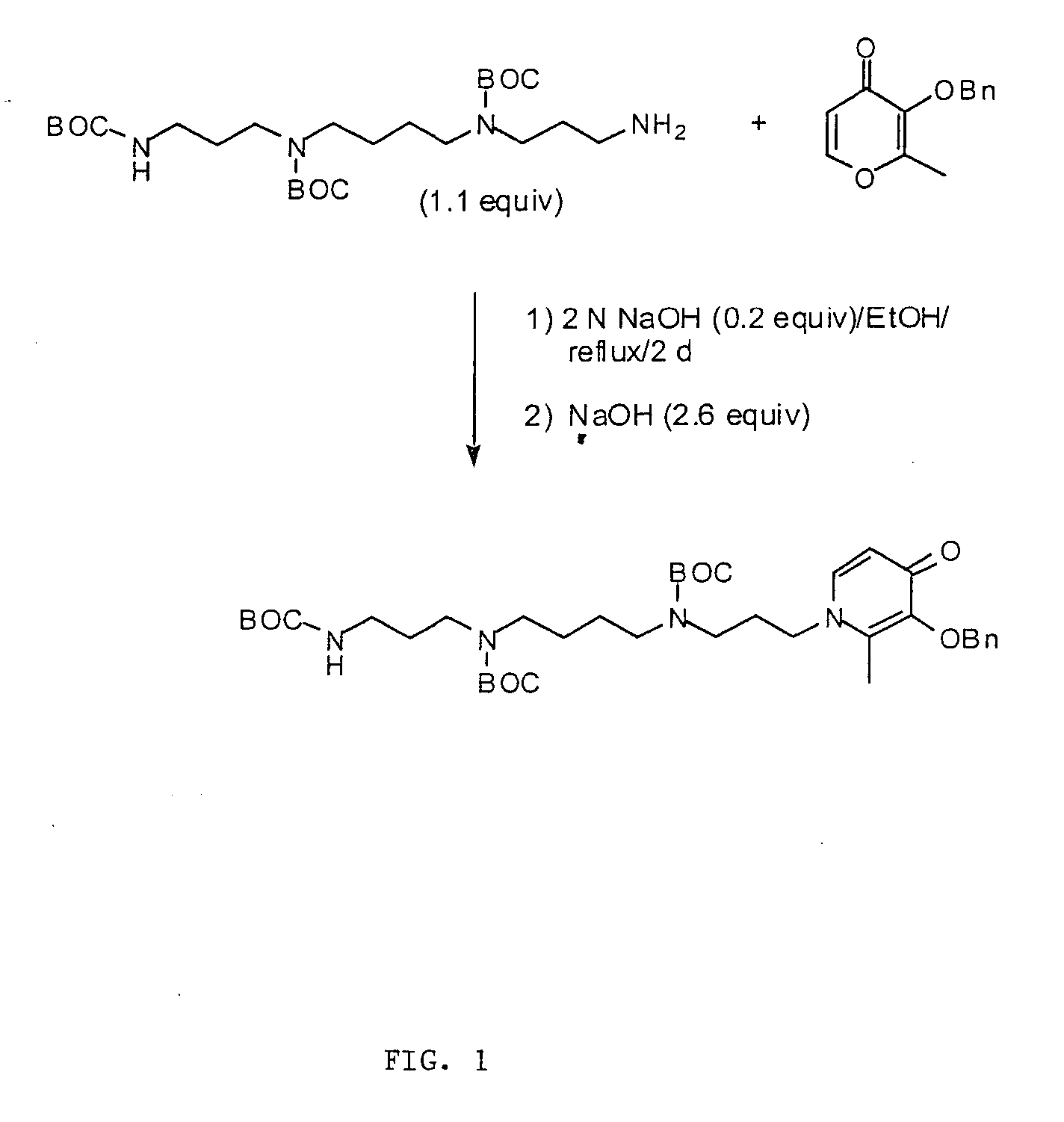Polyamine-metal chelator conjugates
a technology of metal chelator and polyamine, which is applied in the direction of anti-noxious agents, drug compositions, biocide, etc., can solve the problems of metal overload, genetic defect, biological damage, etc., and achieve the effect of simple competitive inhibition and long treatment tim
- Summary
- Abstract
- Description
- Claims
- Application Information
AI Technical Summary
Benefits of technology
Problems solved by technology
Method used
Image
Examples
example 1
Synthesis of 1-(12-Amino-4,9-diazadodecyl)-2-methyl-3-hydroxy-4(1H)-pyridinone Tetrahydrochloride (Compound 3)
[0157] The synthesis is represented schematically in FIG. 1.
[0158] Reagents were purchased from Aldrich Chemical Co. (Milwaukee, Wis.), and Fisher Optima-grade solvents were routinely used. Silica gel 32-63 from Selecto Scientific, Inc. (Suwanee, Ga.) was used for flash column chromatography, and Sephadex LH-20 was obtained from Amersham Biosciences (Piscataway, N.J.). Melting points are uncorrected. NMR spectra were obtained at 300 MHz (1H) or 75 MHz (13C) on a Varian Unity 300 in D2O, with chemical shifts (δ) given in parts per million referenced to sodium 3-(trimethylsilyl)propionate-2,2,3,3-d4 (0.0) or 1,4-dioxane (67.19), respectively. Coupling constants (J) are in hertz. Elemental analyses were performed by Atlantic Microlabs (Norcross, Ga.).
1-(12-Amino-4,9-diazadodecyl)-2-methyl-3-(phenylmethoxy)-4(1H)-pyridinone Tetrahydrochloride (Compound 2)
[0159] Sodium hydrox...
example 2
Stoichiometry of Metal-Ligand Complexes
[0162] 1,2-Dimethyl-3-hydroxypyridin-4-one (L1) was a generous gift from Dr. H. H. Peter (Ciba-Geigy, Basel, Switzerland).
[0163] The stoichiometry of a metal-ligand complex was determined spectrophotometrically for Compound 3 and L1 at the λmax (FIGS. 2A and 2B, 459 and 455 nm, respectively) of the visible absorption band of the ferric complexes. Briefly, a 0.5 mM Fe(III) nitrilotriacetate (NTA) solution was made immediately before use by dilution of a 50 mM Fe(III)-NTA stock solution with TRIS buffer. Solutions of the ferric complex containing different ligand / Fe(III) ratios were then prepared by mixing appropriate volumes of 0.5 mM ligand in 100 mM TRIS Cl, pH 7.4, and 0.5 mM Fe(III)-NTA such that the combined concentration of ligand and Fe(III) was a constant at 1.00 mM. The Job's plot for each set of mixtures was then derived.
[0164] The plots for Compound 3 and L1 were essentially identical, demonstrating that both compounds formed a 3:1...
example 3
Effect of a Conjugate on Cell Proliferation
[0165] N1-Acetylspermine (AcSPM) as its trihydrochloride salt (A-2679) was purchased from Sigma (St. Louis, Mo.).
[0166] Murine L1210 leukemia cells were maintained in logarithmic growth as a suspension culture in RPMI-1640 medium (Gibco, Grand Island, N.Y.) containing 10% fetal bovine serum (Gibco), 2% HEPES-MOPS buffer, 1 mM L-glutamine (Gibco), and 1 mM aminoguanidine at 37° C. in a water-jacketed 5% CO2 incubator.
[0167] Cells were grown in 25 cm2 tissue culture flasks in a total volume of 10 mL. Cultures were treated during logarithmic growth (0.5-1.0×105 cells / mL) with the compounds of interest, reseeded, and incubated as described in Bergeron, R. J., Müller, R., Bussenius, J., McManis, J. S., Merriman, R. L., Smith, R. E., Yao, H., Weimar, W. R., “Synthesis and Evaluation of Hydroxylated Polyimide Analogues as Antiproliferatives,”J. Med. Chem 43: 224-235 (2000). Cell counting and calculation of percent of control growth were also ca...
PUM
| Property | Measurement | Unit |
|---|---|---|
| total volume | aaaaa | aaaaa |
| flow rate | aaaaa | aaaaa |
| flow rate | aaaaa | aaaaa |
Abstract
Description
Claims
Application Information
 Login to View More
Login to View More - R&D
- Intellectual Property
- Life Sciences
- Materials
- Tech Scout
- Unparalleled Data Quality
- Higher Quality Content
- 60% Fewer Hallucinations
Browse by: Latest US Patents, China's latest patents, Technical Efficacy Thesaurus, Application Domain, Technology Topic, Popular Technical Reports.
© 2025 PatSnap. All rights reserved.Legal|Privacy policy|Modern Slavery Act Transparency Statement|Sitemap|About US| Contact US: help@patsnap.com



